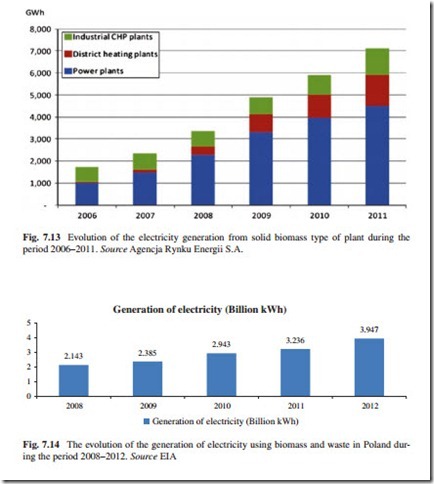Poland
The Polish market for renewable energies has reached a turning point. The new Polish energy policy entails new opportunities for developing biomass power plant projects, particularly at locations of the wood or furniture industry. At present, a total of 11 biomass power plants are operational at the about 450 locations that produce large amounts of biomass. The largest plants are operating at the three large Polish pulp mills, and they are also coincinerators. A total of 8 mono-incinerators at industrial locations are considerably smaller, and they produce less than 5 % of the Polish electricity from biomass. Most potentially favorable locations have not yet been developed. Instead, almost 80 % of the biomass electricity and more than a third of the renewable energies in Poland are generated through coincinerating biomass in coal power plants.13 According to the data collected by the Polish Regulatory Office, there are 15 power plants or their add-on power generation units in Poland using biomass only. Their total capacity is 252.5 MW. Many other coal power plants (30 units) are cofiring biomass with coal.
The new Polish Act on Renewable Energy Sources approved in April 2014 (OZE Bill) supports the use of smaller biomass power plants, mono-incinerators, and electricity generation by using CHP technology.
Solid biomass is a dominant source14—86.9 % of total renewable energy source production in Poland followed by liquid biofuels with 5.4 %, hydro (3.4 %), biogas (2.4 %), wind (1.3 %), heat pumps (0.3 %), geothermal energy (0.2 %), solar energy (0.024 %), and waste (0.004 %). Among renewable energy sources, solid biomass is not only the most important in Poland today, but is expected to be the fastest growing source in the future. However, the share of bio- mass from forestry will be significantly reduced (Burczy et al. 2010).
In 2008, electricity production from biomass amounted to 3,267 GWh, (2,752 GWh in cofiring power plants) and was equal to about 49.7 % of total electricity production from renewable energy sources compared to 43.5 % in 2007, and this share steadily increases. In 2013, about 50 % of the Polish electricity from renewable energy sources was produced from biomass, almost the same that the electricity produced in 2008, and almost a third comes from coincinerating bio- mass in coal-fired power plants.
In 2012, the total electricity generated by biomass and waste power plants reached 9,093 MW. The installed capacity of biomass and waste installations amounted to 184 MW in 2012; this represents 0.53 % of the total electrical capac- ity installed in the country and 5 % of the total renewable electricity capacity installed. Poland occupies the place number 33 with 0.23 % of the world total bio- mass and waste capacity installed and the place number 17 with 0.54 % of the regional total biomass and waste capacity installed.
Around 0.96 million tons of biomass were used to produce electricity in 2007, in addition to almost 4.5 million tons of biomass used for heating purposes. Further estimates show that minimum needs of the energy system and heating sec- tor in Poland will amount to about 10 million tons in total in 2020.
The evolution of the production of electricity from solid biomass by type of plant during the period 2006–2011 is shown in Fig. 7.13.
Generation of Electricity Using Biomass and Waste
The evolution of the generation of electricity using biomass and waste in Poland during the period 2008–2012 is shown in Fig. 7.14.
According to Fig. 7.14, the generation of electricity using biomass and waste in Poland during the period 2008–2012 increased 84.2 %. It is expected that the generation of electricity using this type of energy source will continue increasing during the coming years.
